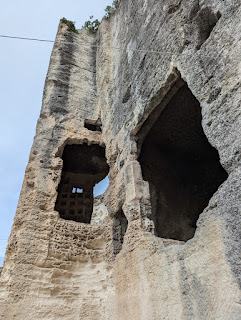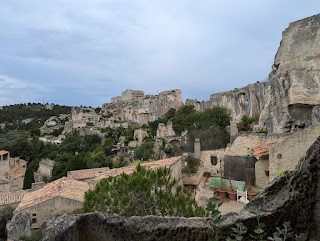90 - People in stone houses shouldn't throw glasses - Avignon, Baux de Provence, & Arles
Tuesday, June 25
It took more effort than expected to make it out of bed and lug the suitcases down the ample stairwell but I did eventually succeed. I left my bags in the bagagerie, planning to come back with the car rather than lug them across the cobblestone streets to the parking lot. My stuff deposited, I resolved to make a quick visit to the Palais des Papes; afterall, why bother coming to Avignon if I wasn't going to see anything.
Inside the palais is a completely self guided tour with a tablet. I don't remember if we went inside the papal palace in high school: the building is big and impressive from the outside but surprisingly spartan inside so maybe I simply forgot. Here's hoping I don't forget again, the place featured a few frescos (a newly learned word for me: it involves painting on the material before it dries) but it seems much of the grandeur in the palace has either burned or been moved off to other places. But I learned a bit of the history and politics (or at least had more of an appetite for it this time).
A nice quiet cloister aside from the starlings chirping up a storm as they flit about
Why set up shop in Avignon? Feuding between the French king Philippe le Bel and the Catholic church results in an attack by the king on the Italian pope's palace. A couple years later, a French bishop is elected pope and he spends much of his time in France to smooth things with the secular government; this includes dissolving the Knights Templar (the order, not the individual knights). Anyhow, Avignon made for a good place to seat the pope due to being in church-controlled lands, being close to the France, and having the Rhône to facilitate trade and travel.
A quick wikipedia search reveals that the film "The Two Popes" isn't about how popes coexisted in both Avignon and Rome for 39 years. To maintain legitimacy, they had negotiated which lands and people each had control over but couldn't come to an agreement over who was the sole pope despite each seat changing hands several times. Hilariously, the council in Pisa even elected a 3rd pope in the hopes that a 3rd party would bring unification. "Oh yeah, this'll help"
The tablet was a neat tool but I wouldn't have minded the museum actually having things rather than play Myst-emon GO.
Check out the vaulted ceiling in the treasure vault! I wonder how much wealth is needed to distinguish between a vault and a hoard.
Some genuine stone coffers i.e. money pits
I took a bit of time to explore the garden, which offered a view of the treasure vault windows well sunk into the tower's walls.
I don't think I've seen an artichoke flower before...
🎵One long staircase just going up, and one even longer coming down. And one more leading nowhere just for show...🎵 Though this one leads to a pigeon.
This room was converted to suit the needs of the court: sometimes it was a banquet hall but sometimes it would have the council of clergy sealed up inside until they elected a new pope. Walls and stairwells were added & removed to meet the function.
A daytime view from the castle rampart; the Rhône looks a little different by daylight compared to last night's view. The walkway to get here was extremely narrow due to scaffolding and lighting for whatever event was being held in the courtyard.
From the palace, I made a quick stop to the Pont of Avignon. I rushed a bit seeing the bridge and didn't realize there were audio guides available; oh well, guess I'll make do with what was on the plaques. Besides, I was getting eager to move on to my next stop of the day.
Sur le pont d'Avignon, l'on y danse, l'on y danse
A small shrine here is dedicated to the sheperd Bénézet, who received a vision instructing him to build a bridge across the Rhône to Avignon. He spent his life rallying people to the cause and raising funding. Once built, the bridge was too narrow for moving cargo and thus was more of a pedestrian foot bridge for pilgrims.
The current bridge is only a fraction of the original length. The bridge was likely only allowed to be construction by the powers at the time for its use in controlling traffic on the Rhône.
Getting the bags was a pain; the guy wouldn't let me drive up to the hotel so it was a bumpy, tiring drag from the hotel to where I managed to park the car. I'll need to re-evaluate how I choose hotels this trip since I'm carrying significantly more baggage than usual.
Next stop, Les Baux de Provence, a recommendation from coworkers. Someone said it's been called one of the most beautiful villages in France; I'm not sure if that's entirely true but it was charming. Les Baux is situated on a limestone plateau extending out from the Alpilles. At only a few hundred meters tall, they provide a great view of the surrounding low lands clear out to sea; the surrounding Alpilles areas also served as limestone quarries.
Reaching les Baux involved parking on a fairly steep slope and then walking up. This gate was used by the locals for descending into the valley to fetch water because the plateau the city is built into doesn't have a spring.
Lots of old stones were showing wear and tear in this town, I found the holes added a certain charm to the place but I imagine they would've made the town a nightmare for someone with trypophobia.
The princes of Monaco once held control of les Baux de Provence, given it (along with other lands) for their aid to Louis XIII; hence a plaza named after a prince of Monaco.
Sorry, ladies, I don't make the rules; I just interpret them. And clearly this church is a no underwear zone
Apparently this was called the vale of hell because the landscape reminded somebody of Dante's description of Hell. Seems a bit harsh for what is now a touristic area mais à chacun son truc
Les Baux de Provence doesn't have a water source, so a giant cistern was created which is now partly occupied by an art exhibit.
Walking through the town, it's evident that it's quite a nice little village. The narrow stone streets suit the stone buildings well and provide a quaint atmosphere that's perfumed by the frequent soap shops.
Les santons, Provençal little figurines. Once only tiny saints and nativity scenes, these little decorations now come in all shapes and patterns.
As I walked through town, I kept thinking back to Bonifacio. A different view but a similar type of town. I did a picnic lunch out on the plateau, munching sausage and cheese while contemplating olive groves, vineyards, and a cool breeze.
I finished with a tour of the castle ruins. They've added several siege engines on the grounds and appear to have fairly frequent medieval themed events for children. The amount of carved stone rooms was impressive. Sadly, the castle was razed at the order of Cardinal de Richelieu: hundreds of years of building destroyed with a few well placed casks of gunpowder. I didn't follow the political explanation exactly: the townsfolk agreed to have the castle destroyed but agreed to pay the king for it; but couldn't afford the debt payments so the king ended up getting the razed castle in the end anyways. I feel like I'm missing a small piece that makes it make sense.
There were no water fountains in Baux, so I ended up fairly dehydrated. I took one look at the Carrier des Lumieres, where light shows of art are projected onto the walls of an old, abandoned limestone quarry. It would have been cool but my parking was expiring and I wanted to get a move on to pay a short visit to another town I'd visited back in highschool: Arles.
I kinda wish I'd had spare time to see the light show, the map indicated that the quarry is quite large
Arles is different from how I remember, which has me seriously questioning what I was doing on my high school trip. It is a thriving city, not the quiet shoulder-high wall town I recalled; I quite liked Arles. Compared to the madness of Avignon, I found Arles very approachable and could see the downtown area being a place people would want to live. I arrived too late to go inside any of the attractions, but I relearned about how the people of Arles had incorporated housing into the Arena. I paid a visit to the Place du Forum where I remembered the café Van Gogh painted was; sadly, the café was closed today. So I had a glass of wine (with some olives to munch) nearby to relax and reenergize a bit before my drive to the hotel.
The area of Arles wasn't as big as that of Nîmes but it had a different look to it too. Arles also had a wealth of other Roman ruins: a theater, a bath house, and even a crypt.
The courtyard of the Van Gogh community cultural center; good thing they had a good picture to work off of for replicating the scene.
Le café la nuit, standing where the subject of Terrase du café le soir was
The evening snack of champions
You'll have to excuse me for keeping both ears for the self-portrait
The drive to Marseille went pretty smoothly until I entered Marseille. Once the highway ended and I was driving the streets of Marseille, it seemed like it was suddenly the wild west of roads: I couldn't make out any lane markings, people were double parking, and scooters/ebikes were all over the place. I breathed a sigh of relief when I finally made it to the hotel; unfortunately, the hotel's parking was back up a 1-way street I'd just come from and involved taking a car elevator. The good news is that I found ample parking in another public parking lot two blocks down that charged roughly the same rate.
On the hunt for a late dinner, I walked along some nice pedestrian areas near the old port and found a place to serve me a traditional bouillabaisse.
Marseille has a reputation in France; all my coworkers told me to be careful whilst visiting. Part of the reputation comes from the city having the some of the highest gun crime rates in France but another piece of it is a reputation of the Marseillais to be brash, loud, and often confrontational. A quick google search shows the 2017 homicide rate in Marseille at 3.5%; but I'm from les États-Unis so I think I'll be fine.




















































































Comments
Post a Comment